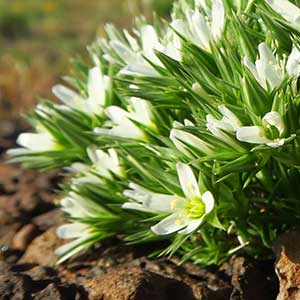Eremogone franklinii
Caryophyllaceae subfam. alsinoideae
Franklin's sandwort
erect, 3–10(–15) cm, glabrous.
prostrate to ascending or erect, simple or branched.
basal leaves persistent;
cauline leaves in 6–10 pairs, closely overlapping, not reduced;
basal blades arcuate-spreading, needlelike, (0.6–)1–2 cm × ca. 1 mm, ± rigid, herbaceous, apex spinose, glabrous, not glaucous.
opposite, connate proximally or not, often petiolate (basal leaves), not stipulate;
blade subulate or linear to spatulate, lanceolate, or broadly ovate, seldom succulent.
3–45+-flowered, usually congested, subcapitate cymes.
terminal or axillary cymes, or flowers solitary;
bracts foliaceous or reduced, herbaceous to scarious (or rarely absent);
involucel bracteoles absent.
ca. 0.1–3(–4) mm, glabrous.
present or rarely flowers sessile.
sepals 1–3-veined, linear-lanceolate, (5–)8.5–12 mm, not enlarging in fruit, margins narrow, apex acuminate, glabrous;
petals white, oblong-lanceolate to narrowly spatulate, 7–9 mm, 0.8–1.1 times as long as sepals, apex rounded to blunt;
nectaries not apparent.
bisexual or seldom unisexual, sometimes inconspicuous;
perianth and androecium hypogynous or perigynous, often slightly;
hypanthium cup-, dish-, or disc-shaped;
sepals (4–)5, distinct or seldom connate basally, sometimes hooded, not awned;
petals absent or (1–)4–5, usually white, sometimes translucent, yellowish white, pink, or brownish, seldom clawed, auricles absent, coronal appendages absent, blade apex entire or 2-fid, sometimes jagged or emarginate, rarely laciniate;
stamens absent or (1–)5(–10), in 1 or 2 whorls, arising from base of ovary, a nectariferous disc, or sometimes the hypanthium or hypanthium rim;
staminodes absent or 1–5(–8);
ovary 1- or rarely 3-locular (Wilhelmsia);
styles (2–)3–5(–6), distinct;
stigmas (2–)3–5(–6).
capsules, or rarely utricles (Scleranthus), opening by (2–)3–6, occasionally 8 or 10 valves or (3 or) 6–10 teeth;
carpophore present or often absent.
2.3–3.3 mm, glabrous.
black, pyriform, 1.2–1.7 mm, tuberculate.
1–60+, yellowish or tan to dark red or often brown or black, usually reniform or triangular to circular and laterally compressed or ovoid to globose, rarely oblong and dorsiventrally compressed (Holosteum);
embryo usually peripheral and curved, rarely central and straight (Holosteum).
= 6–15, 17–19, 23.
Eremogone franklinii
Caryophyllaceae subfam. alsinoideae
Varieties 2 (2 in the flora).
(Discussion copyrighted by Flora of North America; reprinted with permission.)
Genera 30, species ca. 1040 (16 genera, 137 species in the flora).
Alsinoideae, often considered basal in the family and the least specialized, is in some ways the most heterogeneous of the subfamilies. Members of its largest tribe (Alsineae) share the following characteristics: stipules absent, sepals free or at most basally connate, and capsular fruits. Indehiscent fruits, relatively short hypanthia, and other floral reductions occur in varying combinations in the approximately 30 species placed in four other tribes. A broad molecular survey of Alsinoideae has revealed two major lineages and lack of support for the existing tribal circumscriptions (M. Nepokroeff et al. 2002). About three-fourths of the species are members of Arenaria, Cerastium, Minuartia, and Stellaria.
Attempts have been made to move Scleranthus (fruit a utricle surrounded by an enlarged hypanthium) from Alsinoideae to either Paronychioideae (J. Hutchinson 1973, as Illecebraceae) or Scleranthaceae (A. Takhtajan 1997). Recent molecular and morphological studies by R. D. Smissen et. al. (2002, 2003) supported its retention in the Alsinoideae.
(Discussion copyrighted by Flora of North America; reprinted with permission.)
1. Inflorescences tightly congested cymes; pedicels 0.1-1(-3) mm; sepals 8.5-12 mm; petals 0.8-0.9 times as long as sepals | var. franklinii |
1. Inflorescences somewhat congested cymes; pedicels 1-4 mm; sepals 5-8 mm; petals 1-1.1 times as long as sepals | var. thompsonii |
- Local floras:
OR,
WA
- Local Web sites:
CalFlora,
CalPhotos,
Flora NW,
PNW Herbaria
WildflowerSearch
iNaturalist (observations)
- LBJ Wildflower Center
- SEINet
- Plants of the World Online
- Encyclopedia of Life
- Wikipedia
- Google Image Search


